-
ORIGINAL ARTICLE12-16-2024
Respectful care for postpartum women with sickle cell disease: a netnographic study
Revista Brasileira de Enfermagem. 2024;77(6):e20230545
Abstract
ORIGINAL ARTICLERespectful care for postpartum women with sickle cell disease: a netnographic study
Revista Brasileira de Enfermagem. 2024;77(6):e20230545
DOI 10.1590/0034-7167-2023-0545
Views1See moreABSTRACT
Objectives:
to analyze principles of respectful maternity care in narratives of postpartum women with sickle cell disease, relating them to Sustainable Development Goals.
Methods:
netnographic study, with two videos published in 2020. Deductive iconographic and thematic analysis by Respectful Maternity Care Charter, organized in MAXQDA.
Results:
principles identified were the right to: freedom from harm and ill-treatment; information, informed consent, refusal of medical procedures, and respect for their choices and preferences including companion; be considered a person from birth, with dignified and respectful treatment; health at the highest possible level; newborns being with their parents or guardians. The Sustainable Development Goals for women by 2030 were not positively contemplated in postpartum women’s experience.
Final Considerations:
it is appropriate that health workers qualify themselves to provide respectful maternity care, with qualified listening, understanding, and resolution of unique demands of postpartum women with sickle cell disease, seeking equality in care for women.
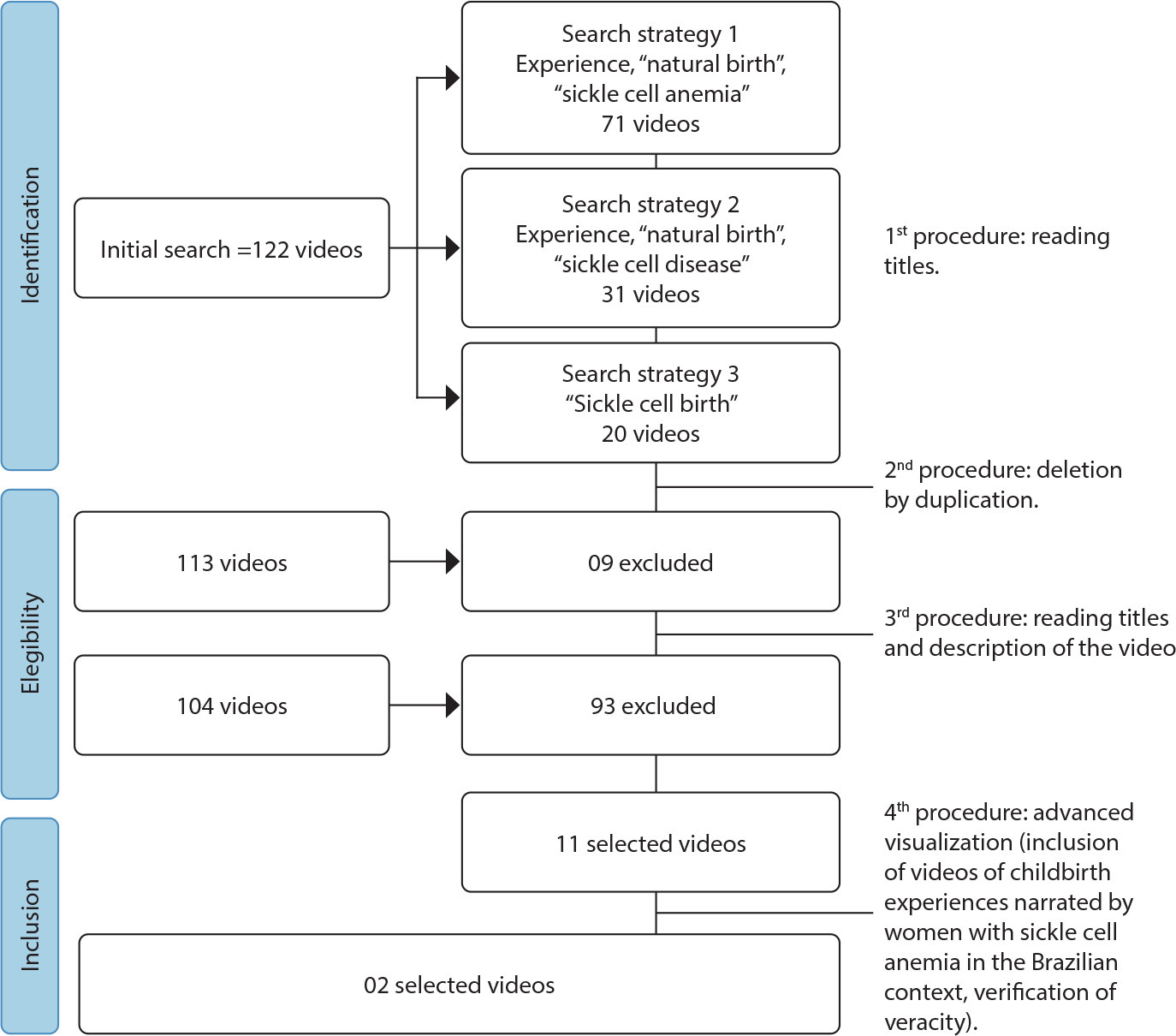
-
12-16-2024
GerenciaDOR™: development of digital technology by nurses for the assessment of patients with chronic pain
Revista Brasileira de Enfermagem. 2024;77(6):e20240050
Abstract
GerenciaDOR™: development of digital technology by nurses for the assessment of patients with chronic pain
Revista Brasileira de Enfermagem. 2024;77(6):e20240050
DOI 10.1590/0034-7167-2024-0050
Views0See moreABSTRACT
Objectives:
to develop a digital technological solution (prototype) for assessing patients with chronic pain.
Methods:
this is a methodological and technological development study based on the Human-Centered Design framework and the principles of Patient-Centered Care. The prototype guides patients through a body diagram and directs them to an evaluation using specific instruments that address the multidimensional aspects of chronic pain.
Results:
the GerenciaDOR* project enables navigation through the Web App screens, providing access to pain assessment features up to the presentation of results.
Final Considerations:
the study describes a systematic approach to pain assessment and expands nurses’ knowledge in pain management. Additionally, it can promote the development of other digital technologies for chronic pain assessment and contribute to a multidisciplinary, patient centered treatment.
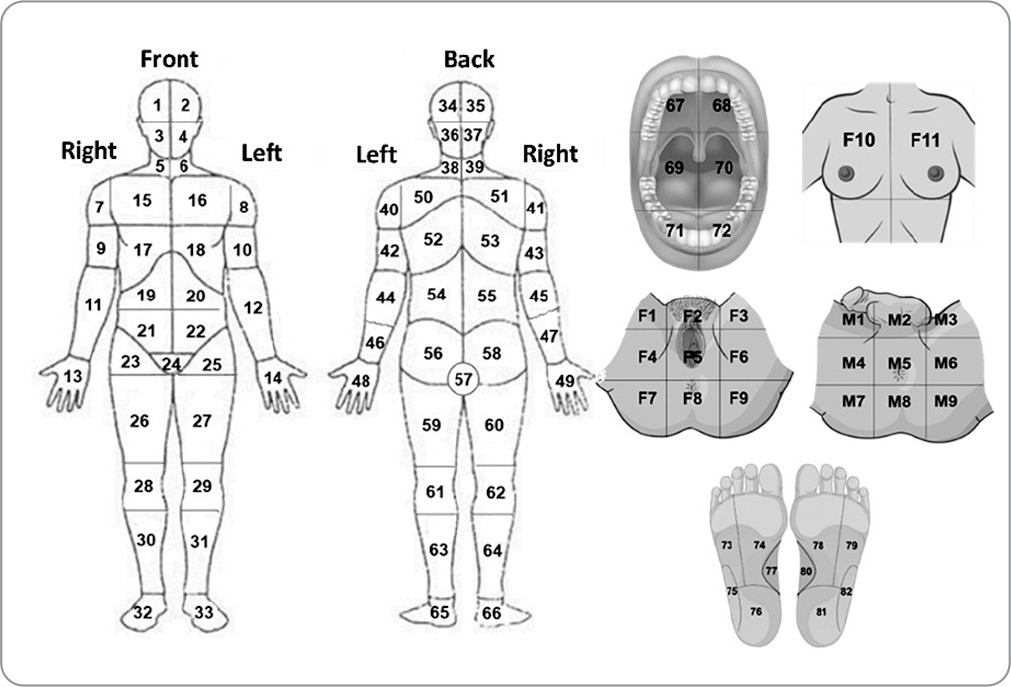
-
ORIGINAL ARTICLE12-16-2024
Psychometric analysis of ProQOL-BR in nursing: building hospital safety and protection
Revista Brasileira de Enfermagem. 2024;77(6):e20240085
Abstract
ORIGINAL ARTICLEPsychometric analysis of ProQOL-BR in nursing: building hospital safety and protection
Revista Brasileira de Enfermagem. 2024;77(6):e20240085
DOI 10.1590/0034-7167-2024-0085
Views0See moreABSTRACT
Objectives:
to analyze the psychometric properties of the ProQOL-BR instrument in hospital nursing professionals.
Methods:
a methodological study to validate the ProQOL-BR. Confirmatory factor analysis, assessment of local and global adjustment quality, Pearson hypothesis testing and Cronbach’s alpha internal consistency analysis were used.
Results:
a total of 490 professionals participated. The model presents adequate quality due to factor weights (λ≥ 0.40), acceptable overall fit quality and adequate chi-square ratio and degrees of freedom (χ2/g.1=2.51) for the parameters of CFI (0.923), GFI (0.902), TLI (0.914) and RMSEA (0.042). In terms of validity, it was shown to be adequate with CC=0.89. The internal consistency obtained by standardized Cronbach’s alpha was 0.761. Criterion validity was shown to be favorable with significant correlations (0.001).
Conclusions:
the instrument was validated regarding content, criteria and reliability. Three questions were removed from the original instrument, ProQOL-BR, leaving the final instrument with 25 questions.
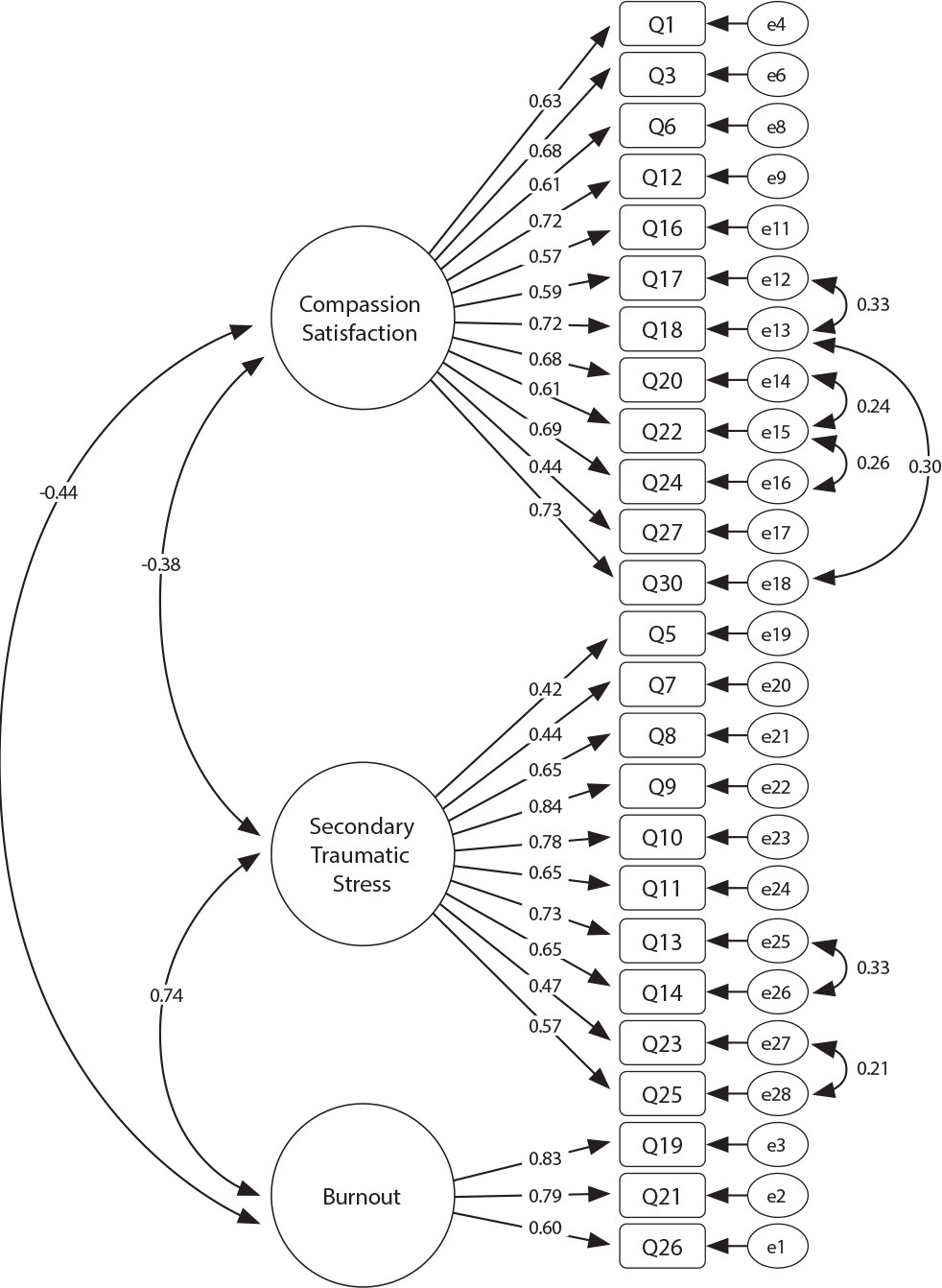
-
REVIEW12-16-2024
Recommendations for guidelines for promoting mental health in the workplace: an umbrella review
Revista Brasileira de Enfermagem. 2024;77(6):e20240086
Abstract
REVIEWRecommendations for guidelines for promoting mental health in the workplace: an umbrella review
Revista Brasileira de Enfermagem. 2024;77(6):e20240086
DOI 10.1590/0034-7167-2024-0086
Views1See moreABSTRACT
Objectives:
to summarize the recommendations of guidelines for promoting mental health in the workplace.
Methods:
an umbrella review, according to Joanna Briggs Institute and Preferred Reporting Items for Systematic reviews and Meta-Analyses methodological assumptions. Data collection was carried out in January 2021 and updated in July 2023 in the American Psychological Association, Cochrane Library, EMBASE, National Library of Medicine, and Scopus databases. Systematic reviews that assessed guidelines with recommendations for mental health care for workers were included. PROSPERO registration CRD42023461845.
Results:
four systematic reviews published between 2015 and 2018 were identified. The abstracts highlighted actions that facilitate and inhibit the recommendations as well as three categories of intervention: primary prevention – worker protection; secondary prevention – promoting workers’ mental health; and tertiary prevention – supporting, monitoring and rehabilitating workers upon returning to work.
Conclusions:
the interventions are based on prevention, promotion and early recognition, support and rehabilitation of mental health problems.
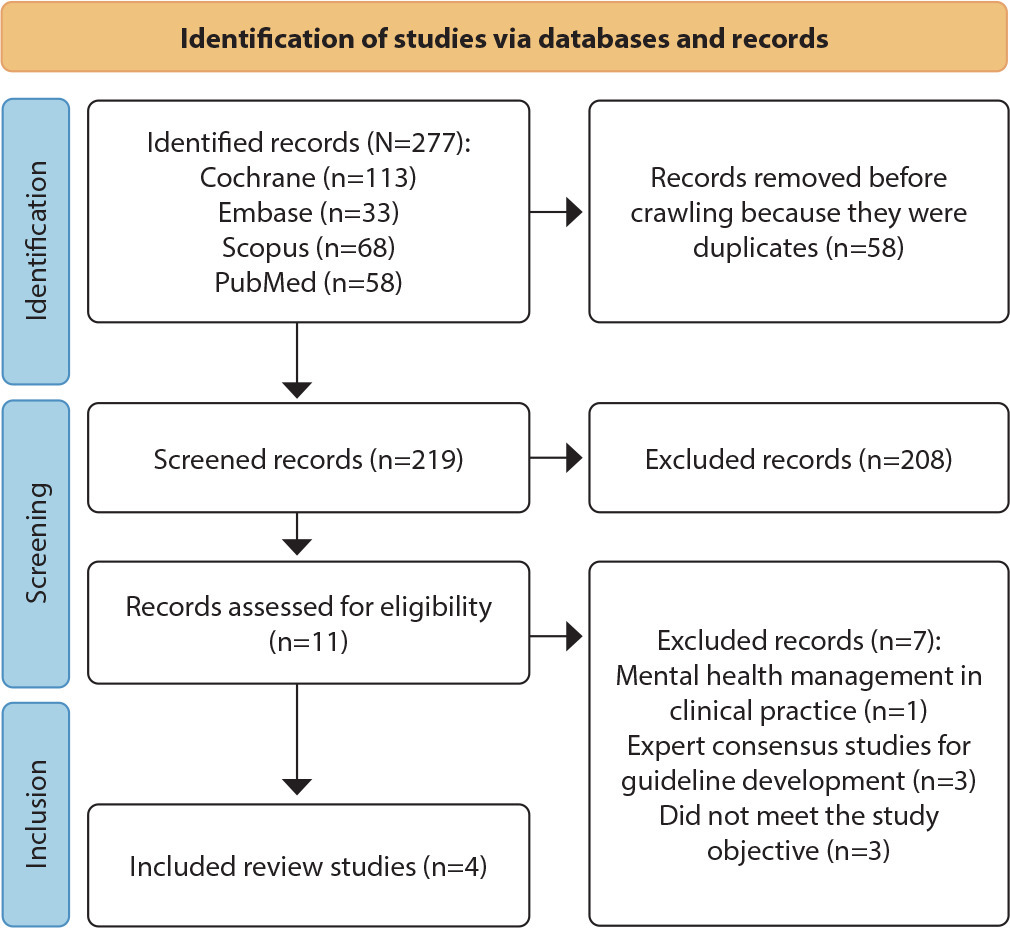
-
ORIGINAL ARTICLE12-16-2024
Analysis of omission of antimicrobial doses in Intensive Care Units
Revista Brasileira de Enfermagem. 2024;77(6):e20240102
Abstract
ORIGINAL ARTICLEAnalysis of omission of antimicrobial doses in Intensive Care Units
Revista Brasileira de Enfermagem. 2024;77(6):e20240102
DOI 10.1590/0034-7167-2024-0102
Views0See moreABSTRACT
Objectives:
to analyze the rate of antimicrobial dose omission in intensive care units.
Methods:
cross-sectional study carried out between March 1 and September 30, 2023, in intensive care units of a University Hospital in Rio de Janeiro.
Results:
the sample consisted of 452 prescriptions and 1467 antimicrobial doses. The dose omission rate was 4.29%. Each antimicrobial prescribed increased the chance of omission by 51%. The strategy of double-checking prescriptions helped prevent 30% of antimicrobial dose omissions (p=0.0001).
Conclusions:
monitoring the omission of antimicrobial doses can guide nursing actions to improve quality and patient safety, contributing to the prevention of medication errors, antimicrobial stewardship and the fight against antimicrobial resistance.
-
ORIGINAL ARTICLE12-16-2024
Health literacy development of Primary Health Care patients: qualitative research
Revista Brasileira de Enfermagem. 2024;77(6):e20240154
Abstract
ORIGINAL ARTICLEHealth literacy development of Primary Health Care patients: qualitative research
Revista Brasileira de Enfermagem. 2024;77(6):e20240154
DOI 10.1590/0034-7167-2024-0154
Views0See moreABSTRACT
Objectives:
to identify the process of health literacy development among primary care patients, relating it to their self-care practices.
Methods:
qualitative, prospective research with 22 patients from two Family Health Strategy units. Data were obtained through individual semi-structured interviews, examined through descriptive statistics and thematic content analysis.
Results:
the results discuss how participants learn about health and how this resonates in their behaviors, culminating in two thematic categories: “Health knowledge construction”; and “Dialogue between health knowledge construction and patient care actions”.
Final Considerations:
health knowledge is developed mainly through interpersonal relationships, mediated by health professionals through bonding and communication. Community educational actions and training of health professionals in communication can promote health literacy and self-care among patients.
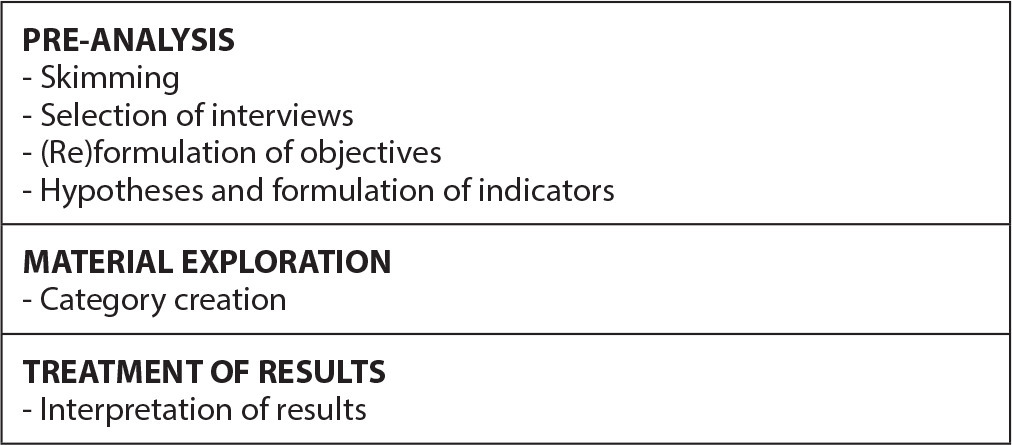
-
ORIGINAL ARTICLE12-16-2024
Bladder ultrasound: evidence of content validity of a checklist for training nurses
Revista Brasileira de Enfermagem. 2024;77(6):e20230183
Abstract
ORIGINAL ARTICLEBladder ultrasound: evidence of content validity of a checklist for training nurses
Revista Brasileira de Enfermagem. 2024;77(6):e20230183
DOI 10.1590/0034-7167-2023-0183
Views0See moreABSTRACT
Objectives:
to develop and analyze evidence of content validity of a checklist for training nurses in measuring bladder volume through ultrasound.
Methods:
a methodological study, consisting of three stages: literature review; instrument item preparation; and analysis of evidence of content validity. The Content Validity Index (CVI) and Gwet’s AC2 were used for content validity analyses.
Results:
the checklist consisted of 23 items. The CVIs for clarity, relevance and dimensionality were 0.99, 0.99 and 0.98 respectively, and the CVIs for Gwet’s AC2 with coefficients for clarity, relevance and dimensionality were 0.89, 0.97 and 0.95, respectively, with p<0.001.
Conclusions:
the checklist developed for training nurses in measuring bladder volume through ultrasound achieved adequate evidence of content validity, and can be used to train nurses in clinical practice and future research.
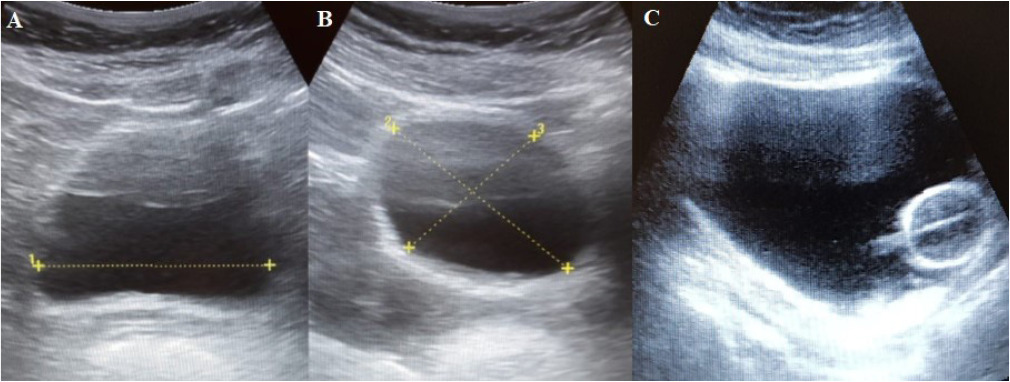
-
12-16-2024
A relação entre gênero, formação educacional e ambiente de aprendizagem com a ansiedade do estudante de enfermagem
Revista Brasileira de Enfermagem. 2024;77(6):e20220615
Abstract
A relação entre gênero, formação educacional e ambiente de aprendizagem com a ansiedade do estudante de enfermagem
Revista Brasileira de Enfermagem. 2024;77(6):e20220615
DOI 10.1590/0034-7167-2022-0615
Views1See moreRESUMEN
Objetivos:
identificar las variables asociadas a la práctica clínica relacionadas con la ansiedad de los estudiantes de enfermería.
Métodos:
se utilizó un diseño descriptivo, cuantitativo, correlacional con las recomendaciones STROBE, EQUATOR. La población fue de 233 estudiantes de enfermería con una muestra de 135 personas. Los datos se recopilaron de marzo a abril de 2022 utilizando instrumentos validados.
Resultados:
la prueba de chi-cuadrado y razón de verosimilitud significativa para género, formación académica y entorno de aprendizaje son superiores a 0.05, por lo que no existe una relación significativa entre las variables y la ansiedad de los estudiantes.
Conclusiones:
los estudiantes necesitan prepararse nuevamente antes de ingresar al campo de la práctica. Investigaciones cualitativas también son necesarias.
-
EXPERIENCE REPORT01-01-2018
Clinical and epidemiological teaching of dengue through simulated practice
Revista Brasileira de Enfermagem. 2018;71(2):451-456
Abstract
EXPERIENCE REPORTClinical and epidemiological teaching of dengue through simulated practice
Revista Brasileira de Enfermagem. 2018;71(2):451-456
DOI 10.1590/0034-7167-2016-0503
Views2See moreABSTRACT
Objective:
to describe the experience of clinical teaching on dengue and the practice of epidemiological surveillance using problematization methodology.
Method:
report of experience on educational activity with undergraduate nursing students, held in March 2016, at a public university in the city of São Paulo, conceived in four stages: dialogic lecture, active search of Aedes aegypti, case study and simulation of nursing consultation to individuals with dengue.
Results:
The activity allowed to retrieve previous knowledge about the disease, respond to exercises that addressed different clinical situations and epidemiological surveillance, including in situ evaluation of possible mosquito outbreaks, and discuss the need to expand prevention and health of the individual and the community, the impact of the media in the dissemination of cases and the coping difficulties experienced in the different levels of attention.
Conclusion:
the methodology adopted enabled qualified training of students to cope with dengue.

-
ORIGINAL ARTICLE07-18-2022
Beliefs, knowledge, actions of nursing techniques in breastfeeding in pain management in immunization
Revista Brasileira de Enfermagem. 2022;75(6):e20210546
Abstract
ORIGINAL ARTICLEBeliefs, knowledge, actions of nursing techniques in breastfeeding in pain management in immunization
Revista Brasileira de Enfermagem. 2022;75(6):e20210546
DOI 10.1590/0034-7167-2021-0546
Views1See moreABSTRACT
Objective:
Understand the beliefs, knowledge, and actions of nursing technicians on breastfeeding as a form of non-pharmacological intervention to relieve pain in newborns and infants during immunization.
Methods:
Qualitative study carried out through semi-structured interviews with nine nursing technicians from three Basic Health Units in a city in the state of São Paulo. The theoretical approach of the Belief Model and the methodological framework of Thematic Analysis supported this study.
Results:
Three themes originated: Beliefs, Knowledge, and Actions of nursing technicians.
Final considerations:
Despite knowledge about the benefits of breastfeeding as the most effective method for relieving pain in newborns and infants during vaccination, their restrictive beliefs overrode the evidence, leading them to act in ways that discourage or prevent the mother from breastfeed during vaccination. Formal training is recommended to align with current evidence-based practices.
-
REVIEW12-08-2023
Educational technologies for accident prevention due to falls in childhood: a scoping review
Revista Brasileira de Enfermagem. 2023;76:e20220807
Abstract
REVIEWEducational technologies for accident prevention due to falls in childhood: a scoping review
Revista Brasileira de Enfermagem. 2023;76:e20220807
DOI 10.1590/0034-7167-2022-0807
Views2See moreABSTRACT
Objectives:
to map evidence on educational technology use for accident prevention due to falls in childhood.
Methods:
a scoping review, carried out in October and November 2022, in the MEDLINE, Web of Science, BDENF and CINAHL databases and LILACS bibliographic index. There was no delimitation of language or time. Data were extracted and analyzed descriptively by two independent researchers. The research protocol was registered in the Open Science Framework.
Results:
twenty-six studies were selected. Booklets, pamphlets and leaflets were the most used technologies, presenting health services as the most frequent environment to develop research on fall prevention. The technologies developed were important outcomes: increased knowledge of children, family members, caregivers, health and education professionals.
Conclusions:
educational technology use makes it possible to increase knowledge, adopt safe practices and reduce falls.

-
REVIEW03-15-2024
Resources for health literacy among caregivers of prematurely born children: a scoping review
Revista Brasileira de Enfermagem. 2024;77(1):e20230062
Abstract
REVIEWResources for health literacy among caregivers of prematurely born children: a scoping review
Revista Brasileira de Enfermagem. 2024;77(1):e20230062
DOI 10.1590/0034-7167-2023-0062
Views1See moreABSTRACT
Objectives:
to map the available evidence on resources used to promote health literacy among caregivers of prematurely born children during outpatient follow-up.
Methods:
the Joanna Briggs Institute’s scope review protocol was utilized. The search encompassed six databases, incorporating studies from 2012 to 2022.
Results:
the three included publications revealed that the resources employed are: mobile applications, phone calls, individual counseling, videos, educational pamphlets, and group discussions. Implementing an education protocol during the transition home enhances scientifically grounded health promotion rates.
Conclusions:
there is limited literature addressing the health literacy of these caregivers. The nursing team plays a crucial role in health education and in developing resources applicable to these families.

-
ORIGINAL ARTICLE01-13-2024
Social representations of oncologic surgery for patients with cancer
Revista Brasileira de Enfermagem. 2024;77(6):e20230273
Abstract
ORIGINAL ARTICLESocial representations of oncologic surgery for patients with cancer
Revista Brasileira de Enfermagem. 2024;77(6):e20230273
DOI 10.1590/0034-7167-2023-0273
Views2See moreABSTRACT
Objectives:
to analyze the social representations of patients with cancer regarding oncologic surgery.
Methods:
a qualitative study based on Social Representation Theory was conducted with 126 participants between October 2021 and May 2022 in a public hospital in Rio de Janeiro. A characterization questionnaire, free evocations of the inducing term “surgery”, and semi-structured interviews with 60 participants were applied. Data were analyzed using Microsoft Excel® and IRaMuTeQ.
Results:
the central core of the representation is composed of fear, cure, hope, and removing the disease. The analysis of interviews resulted in six classes that highlight the social changes caused by treatment as well as the need for a support network to cope with the surgical process.
Final Considerations:
the representations reflect fear and hope towards the procedure and the desire to remove the disease, thus translating the cure through surgery.

-
ORIGINAL ARTICLE01-13-2024
Nurses’ perspectives on the use of telemonitoring in the management of people with diabetes and hypertension
Revista Brasileira de Enfermagem. 2024;77(6):e20230481
Abstract
ORIGINAL ARTICLENurses’ perspectives on the use of telemonitoring in the management of people with diabetes and hypertension
Revista Brasileira de Enfermagem. 2024;77(6):e20230481
DOI 10.1590/0034-7167-2023-0481
Views3See moreABSTRACT
Objectives:
to understand the perspective of nurses on the use of telemonitoring in the management of people with type 2 diabetes mellitus and arterial hypertension in primary care.
Methods:
this qualitative research involved sixteen nurses from eight municipalities in Paraná. Data were collected between November 2022 and January 2023 through inperson or remote interviews, which were audio-recorded and subjected to content analysis.
Results:
according to the nurses, telemonitoring enhances users’ knowledge about these conditions, communication and connection with the team, and productivity. However, the lack of electronic resources and equipment, high staff turnover, low user adherence, and the limited availability of professional time present significant challenges.
Final Considerations:
the effective implementation and operation of telemonitoring in the management of people with diabetes and hypertension involve both potential benefits and barriers. It is essential to have the availability of human and technological resources, managerial support, and the commitment of professionals and users.
-
ERRATUM01-13-2024
ERRATUM
Revista Brasileira de Enfermagem. 2024;77(6):e2024n6e08
Abstract
ERRATUMERRATUM
Revista Brasileira de Enfermagem. 2024;77(6):e2024n6e08
DOI 10.1590/0034-7167.20247706e08
Views2In the article “Brazilian nursing specific situation, middle and micro-range theories: a bibliometric study”, with DOI number: , published in Revista Brasileira de Enfermagem, 2024;77(4):e20230520, Chart 1:Where it read:[…]See more -
ORIGINAL ARTICLE09-29-2022
Palliative care production for health professionals in the context of home care
Revista Brasileira de Enfermagem. 2022;75(1):e20210030
Abstract
ORIGINAL ARTICLEPalliative care production for health professionals in the context of home care
Revista Brasileira de Enfermagem. 2022;75(1):e20210030
DOI 10.1590/0034-7167-2021-0030
Views1See moreABSTRACT
Objectives:
to analyze palliative care production developed by health professionals to home care patients.
Methods:
this is an exploratory study, with a qualitative approach, using the transpersonal care theoretical framework. Thirteen interviews were conducted with health professionals and 18 observations were conducted on different cases. Content analysis was performed using MAXQDA©.
Results:
actions performed: maintenance and follow-up measures to people eligible for palliative care, in acts of dialogue and “listening” to caregivers and users, conducting guidelines for the care and self-care process, performing technical procedures, delivery of materials, referrals and medical prescriptions to users.
Final Considerations:
it is perceived the need for advances in the implementation of government policies in Brazil that insert palliative care into the Health Care Network through educational, managerial and care actions that ensure human dignity, thus allowing the development of these and other palliative care interventions.
-
REVIEW09-09-2022
Factors associated with inadequate treatment of syphilis during pregnancy: an integrative review
Revista Brasileira de Enfermagem. 2022;75(6):e20210965
Abstract
REVIEWFactors associated with inadequate treatment of syphilis during pregnancy: an integrative review
Revista Brasileira de Enfermagem. 2022;75(6):e20210965
DOI 10.1590/0034-7167-2021-0965
Views0See moreABSTRACT
Objectives:
to analyze the evidence available in literature on factors associated with inadequate treatment of syphilis in pregnant women.
Methods:
an integrative review, carried out in the LILACS, CINAHL, Web of Science, Scopus, PubMed and EMBASE databases, with controlled descriptors therapeutic and prenatal syphilis.
Results:
nine publications composed the interpretative analysis, in which low education, income and maternal age, temporary lack of medication and HIV infection were associated with inadequate treatment of syphilis during pregnancy, in addition to delay or absence of prenatal care and receiving the 1st dose of penicillin, lack of tests or treatment less than 30 days before childbirth, and partners’ low compliance with treatment.
Final Considerations:
among the main factors associated with inadequate treatment, clinical and sociodemographic aspects stand out, as well as failures in drug dispensing, prescription and monitoring of treatment of pregnant women and their partners by the health system.
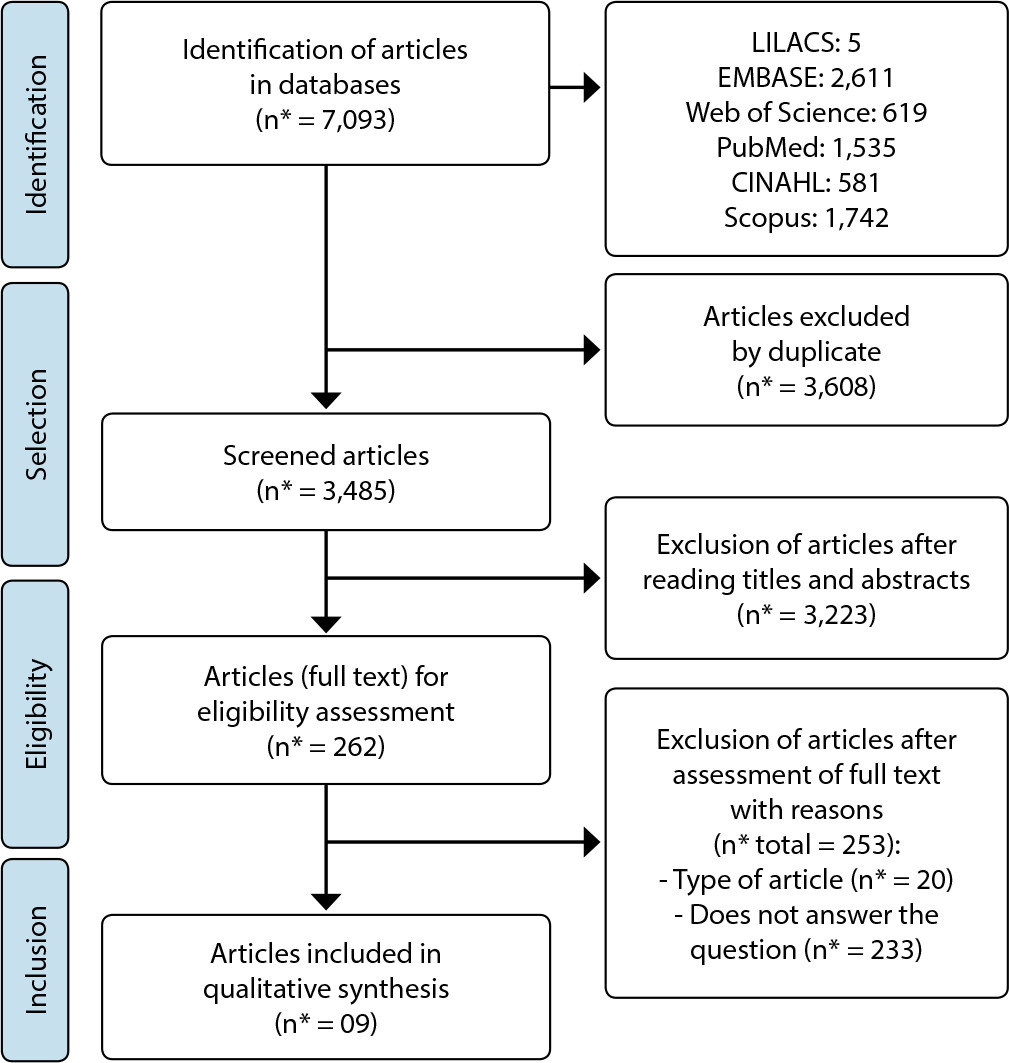
-
ORIGINAL ARTICLE07-08-2020
Older adults with physical disabilities: vulnerabilities relative to the body, the physical and social environment
Revista Brasileira de Enfermagem. 2020;73:e20190175
Abstract
ORIGINAL ARTICLEOlder adults with physical disabilities: vulnerabilities relative to the body, the physical and social environment
Revista Brasileira de Enfermagem. 2020;73:e20190175
DOI 10.1590/0034-7167-2019-0175
Views0See moreABSTRACT
Objective:
to understand the vulnerabilities of older adults with physical disabilities regarding their body, physical and social environments.
Method:
this was a qualitative study based on Alfred Schütz’ social phenomenology, with 15 older adults with physical disability from Cuiabá, state of Mato Grosso, Brazil. Open-ended questionnaires were administered to the participants in 2017. The units of meaning that emerged were organized into thematic categories.
Results:
physical decline, associated with the permanence of environmental and social barriers intensified the vulnerabilities of older adults. Gaps in health services are mitigated by informal social support networks and access to work was a form of social inclusion.
Final considerations:
vulnerabilities in the old age of persons with physical disabilities did not reside only in the body dimension, but also the physical and social environment, countering healthcare models based on the logic of reverting their dysfunctional body.
-
ORIGINAL ARTICLE07-01-2020
Knowledge of primary health care professionals on health policies for the riverside population
Revista Brasileira de Enfermagem. 2020;73(5):e20190080
Abstract
ORIGINAL ARTICLEKnowledge of primary health care professionals on health policies for the riverside population
Revista Brasileira de Enfermagem. 2020;73(5):e20190080
DOI 10.1590/0034-7167-2019-0080
Views0See moreABSTRACT
Objectives:
to analyze the knowledge of health professionals on the health policies for the riverside population; identify how health practices with this group are developed; and discuss facilitators and barriers for the implementation of these policies.
Methods:
qualitative and descriptive study with 24 professionals from the Riverside Family Health Strategy Teams in the city of Belém-Pará. Data were collected in individual interviews and analyzed by Content Analysis.
Results:
although professionals demonstrate knowledge about public health policies, there is a need to expand and strengthen knowledge about health policies for the riverside population. The activities directed to the communities took place in the Unit itself, and some did not occur due to insufficient material and human resources.
Final Considerations:
the greatest barrier for the organization of health care is the lack of material and human resources, and the most prominent facilitator was the union and cohesion of the health team.
-
ORIGINAL ARTICLE07-23-2021
Quality indicators of the nursing process documentation in clinical practice
Revista Brasileira de Enfermagem. 2021;74(3):e20201355
Abstract
ORIGINAL ARTICLEQuality indicators of the nursing process documentation in clinical practice
Revista Brasileira de Enfermagem. 2021;74(3):e20201355
DOI 10.1590/0034-7167-2020-1355
Views0See moreABSTRACT
Objectives:
to propose quality indicators for clinical nursing documentation
Methods:
methodological study in which literature review guided the composition of an instrument for evaluating nursing documentation. Two independent professionals evaluated 204 medical records of adult patients. The analysis of this assessment generated quality indicators for clinical nursing documentation. Inter-rater agreement was analyzed by Cohen’s kappa.
Results:
the bibliographic review, analysis by experts and pre-test resulted in 88 evaluation items distributed in seven topics; in 88.5% of the items, inter-rater agreement between strong and almost perfect (k=0.61-1.0) was observed. Analysis of the evaluations generated a global indicator and seven partial indicators of documentation quality. Compliance in the two services ranged between 62.3% and 93.4%. The global indicator showed a 2.1% difference between services.
Conclusions:
seven quality indicators of clinical nursing documentation and their method of application in hospital records have been proposed.
-
05-28-2021
Challenges of nursing care in psychosocial rehabilitation: a study from the constructionist perspective
Revista Brasileira de Enfermagem. 2021;74:e20200408
Abstract
Challenges of nursing care in psychosocial rehabilitation: a study from the constructionist perspective
Revista Brasileira de Enfermagem. 2021;74:e20200408
DOI 10.1590/0034-7167-2020-0408
Views0See moreABSTRACT
Objective:
To identify the nursing staff’s difficulties in providing care in psychosocial rehabilitation to CAPS users.
Methods:
Qualitative study based on constructionism. Sixteen members of the CAPS nursing staff participated in the study in the city of Rio de Janeiro. The data collected in the interviews and observations were organized in Nvivo software and analyzed based on thematic content.
Results:
The difficulties identified were: the territorial violence that imposes a silence to the actions of CAPS, low user education as a barrier to protagonism, impaired family adhesion, the technical-conceptual discomfort of nursing in acting in the crisis and material and human of CAPS dismantlement.
Final considerations:
The challenges consist of overcoming staff exhaustion; however, they do not prevent nursing from betting on the possibility of protagonist care. Therefore, such care is dimensioned by the clinical-political-ethical relation in constant negotiation with the territory.
-
EXPERIENCE REPORT09-01-2021
Process modeling: technological innovation to control the risk for perioperative positioning injury
Revista Brasileira de Enfermagem. 2021;74:e20200145
Abstract
EXPERIENCE REPORTProcess modeling: technological innovation to control the risk for perioperative positioning injury
Revista Brasileira de Enfermagem. 2021;74:e20200145
DOI 10.1590/0034-7167-2020-0145
Views0See moreABSTRACT
Objectives:
to report the construction of a process model to support the decision making of operating room nurses to control the risk for perioperative positioning injury.
Methods:
experience report on a process model that helps nurses with decision making regarding clients at risk for perioperative positioning injury. By following the steps, it was possible to identify intrinsic and extrinsic variables of the literature and of the workflows of teams involved in the positioning of the client for surgery. The Business Process Model and Notation, the Bizagi Modeler software and terms from the International Classification for Nursing Practice were used in the model.
Results:
the experience allowed the observation of the knowledge integration between different areas, which enabled the process modeling and its validation.
Conclusions:
process modeling is an innovative option for the development of support systems for clinical nursing decisions.
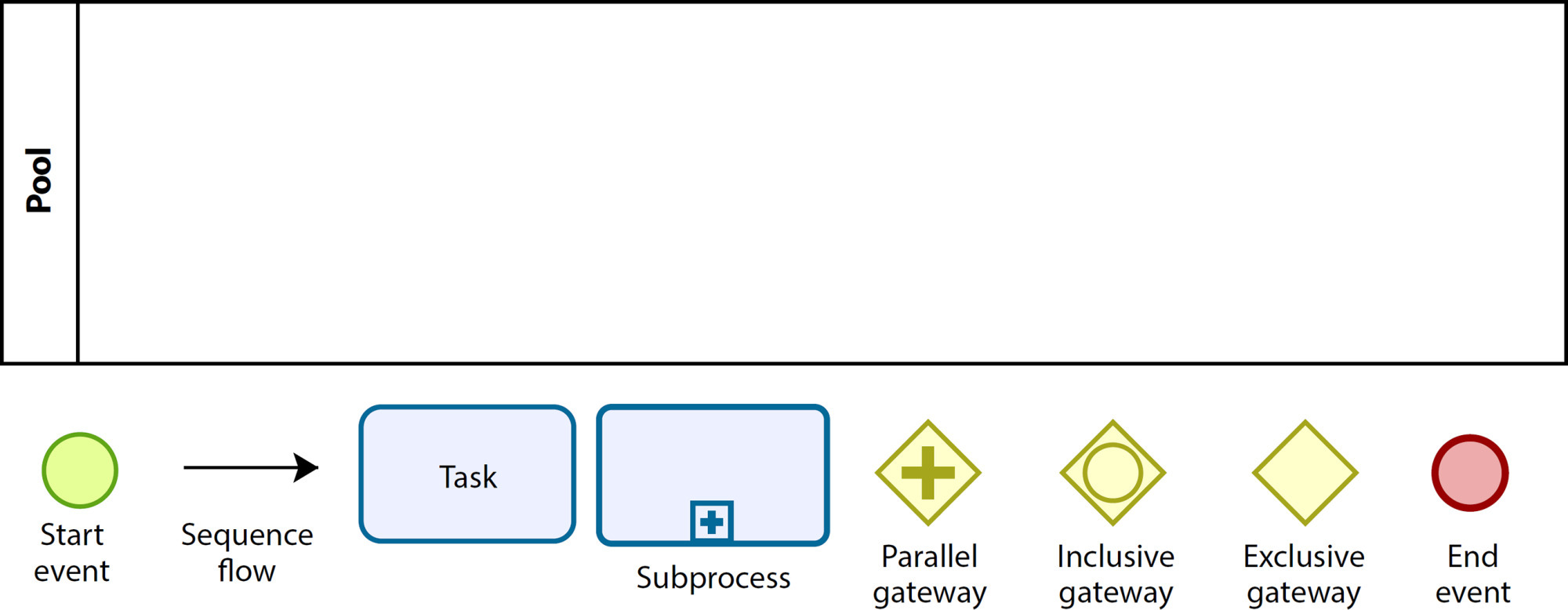
-
ORIGINAL ARTICLE10-01-2022
Coping in mental health during social isolation: analysis in light of Hildegard Peplau
Revista Brasileira de Enfermagem. 2022;75(2):e20201207
Abstract
ORIGINAL ARTICLECoping in mental health during social isolation: analysis in light of Hildegard Peplau
Revista Brasileira de Enfermagem. 2022;75(2):e20201207
DOI 10.1590/0034-7167-2020-1207
Views0See moreABSTRACT
Objectives:
to analyze the coping of individuals in social isolation due to suspicion or confirmation of coronavirus infection from the perspective of Hildegard Peplau’s Theory of Interpersonal Relations.
Methods:
this is a qualitative, descriptive research, carried out with 34 individuals in social isolation due to suspicion or confirmation of coronavirus infection who passed through a screening tent of a university hospital in Paraná. Data were collected through semi-structured interviews in June and July 2020. Empirical categories were interpreted by content analysis.
Results:
four categories emerged: Distance; Social and emotional support; Self-awareness and resolution; Learning. These categories established the coping strategies.
Conclusions:
individuals undergoing social isolation are more likely to present problems related to mental health. It was highlighted that coping strategies, motivated by nurses, anchored in Hildegard Peplau’s theoretical framework, promoted the necessary learning for promoting participants’ mental health in the face of a pandemic context.
-
ORIGINAL ARTICLE11-28-2023
Brazilian undergraduate nursing students’ critical thinking need to be increased: a cross-sectional study
Revista Brasileira de Enfermagem. 2023;76(1):e20220315
Abstract
ORIGINAL ARTICLEBrazilian undergraduate nursing students’ critical thinking need to be increased: a cross-sectional study
Revista Brasileira de Enfermagem. 2023;76(1):e20220315
DOI 10.1590/0034-7167-2022-0315
Views0See moreABSTRACT
Objectives:
to map Brazilian undergraduate nursing students’ critical thinking level and investigate the correlation between selected sociodemographic data and critical thinking domains.
Methods:
in this descriptive cross-sectional study, participants’ (N=89) critical thinking was assessed using the Health Science Reasoning Test. Correlation between critical thinking domains and sociodemographic data was assessed using the Pearson correlation coefficient.
Results:
the overall results showed a moderate level of participants’ critical thinking (mean = 70.7; standard deviation 5.7). A poor performance was identified in 5 of the 8 critical thinking domains. A significant positive correlation was found between education period and critical thinking (p<.001).
Conclusions:
poor level in students critical thinking domains may lead to negative consequences for their learning outcomes. Further studies should be carried out to confirm our results, in addition to investigation of teaching methods that encourage and ensure the development of students’ critical thinking skills during nursing education.
Search
Search in:
Nuvem de Tags
Adolescente (85) Atenção Primária à Saúde (239) COVID-19 (91) Criança (91) Cuidados de Enfermagem (269) Educação em Enfermagem (151) Educação em Saúde (139) Enfermagem (930) Enfermagem Pediátrica (86) Estudantes de Enfermagem (77) Estudos de Validação (131) Família (87) Idoso (208) Promoção da Saúde (99) Qualidade de Vida (104) Saúde do Trabalhador (86) Saúde Mental (145) Saúde Pública (82) Segurança do Paciente (150) Tecnologia Educacional (100)



